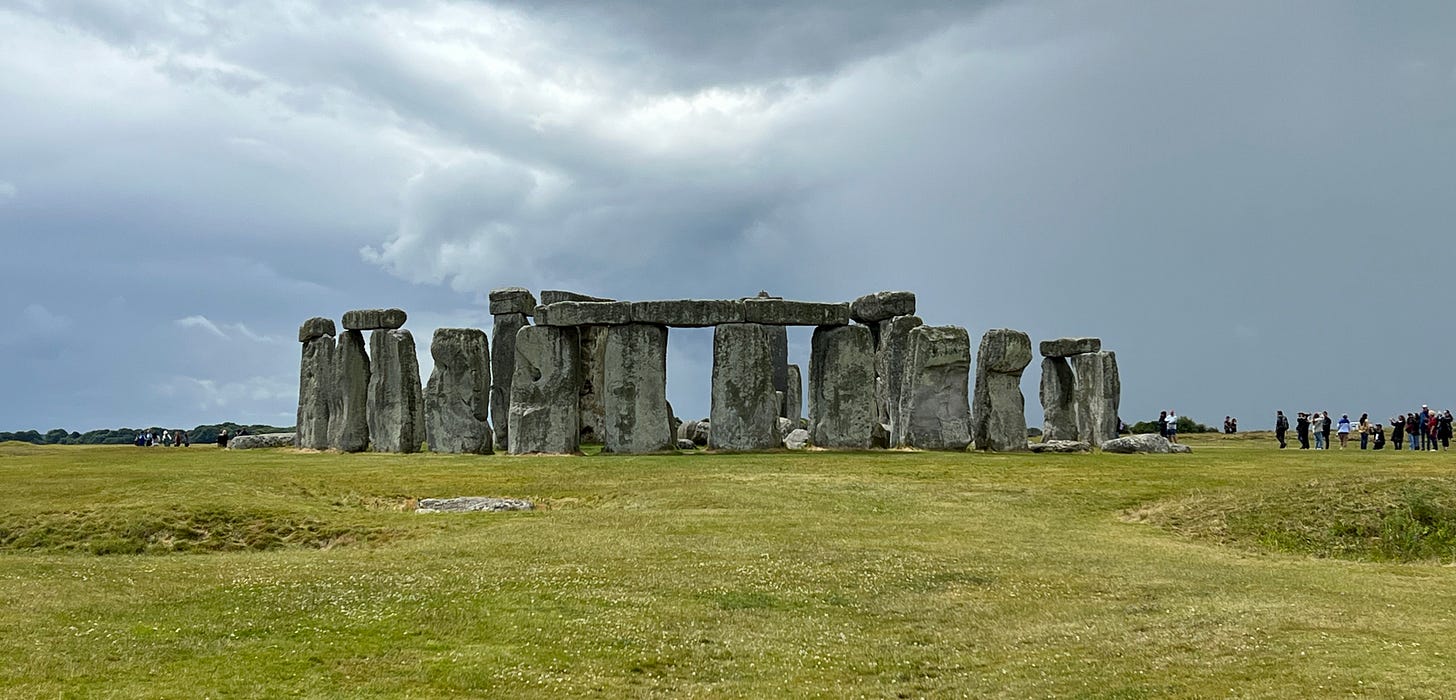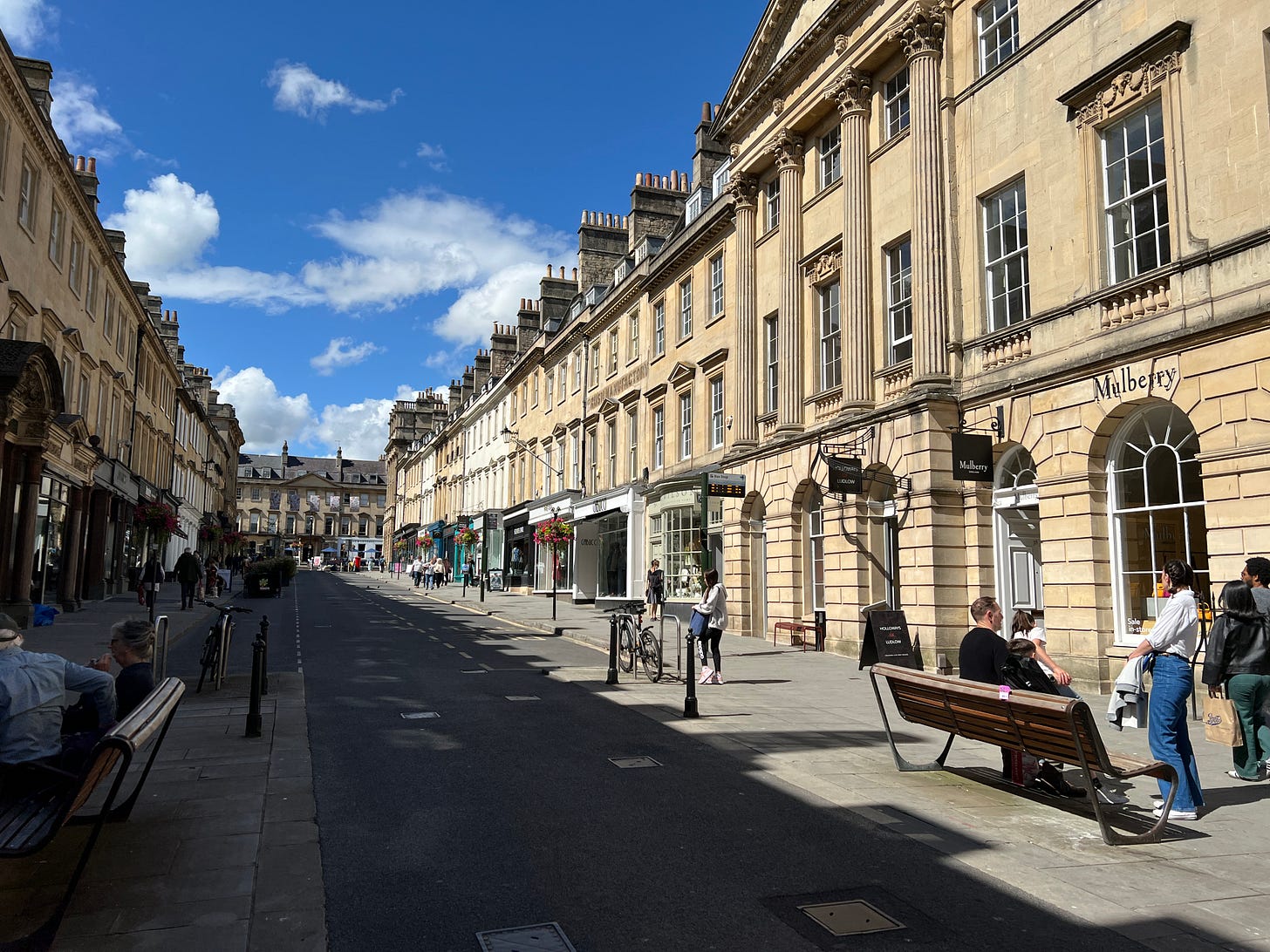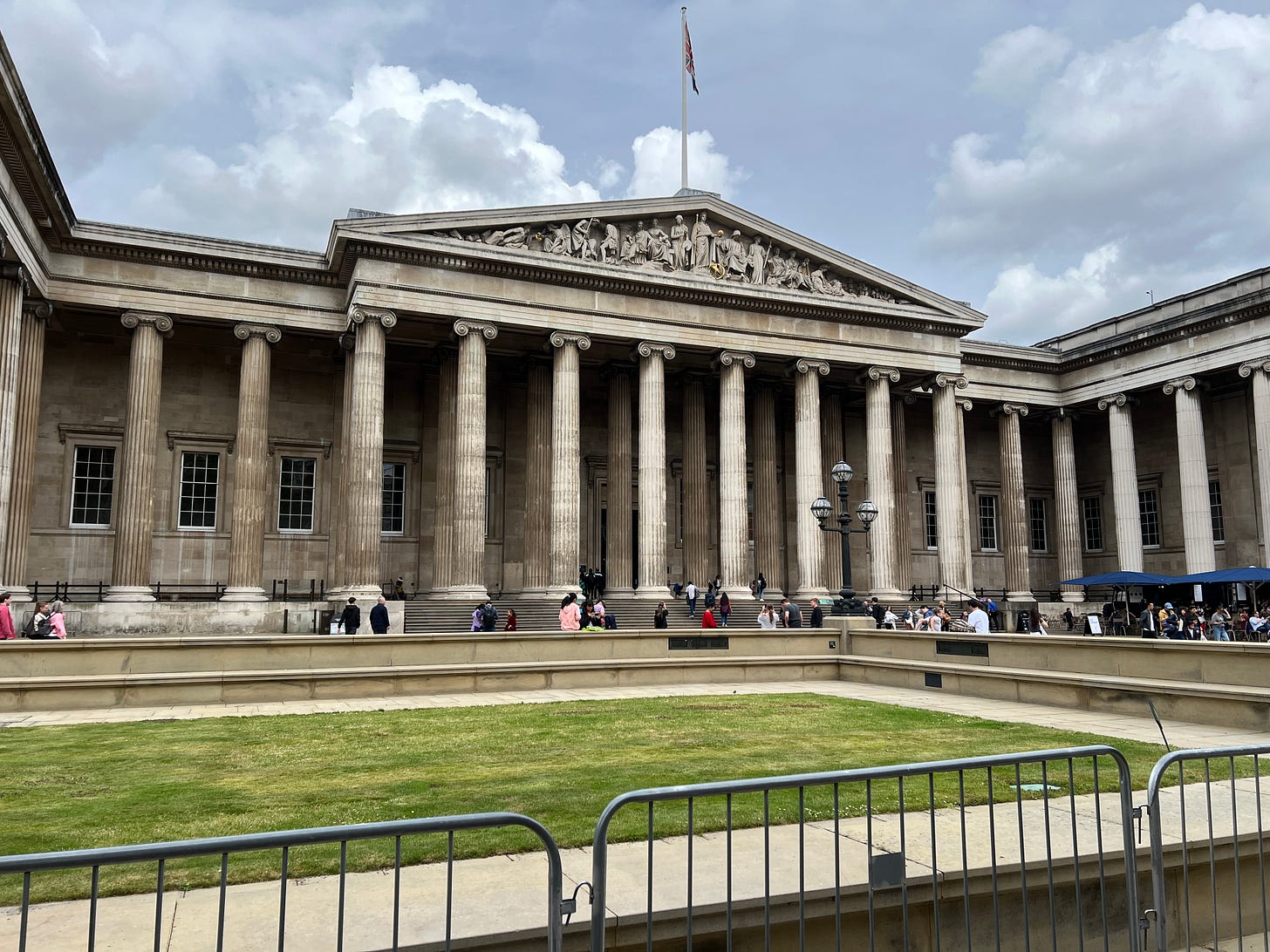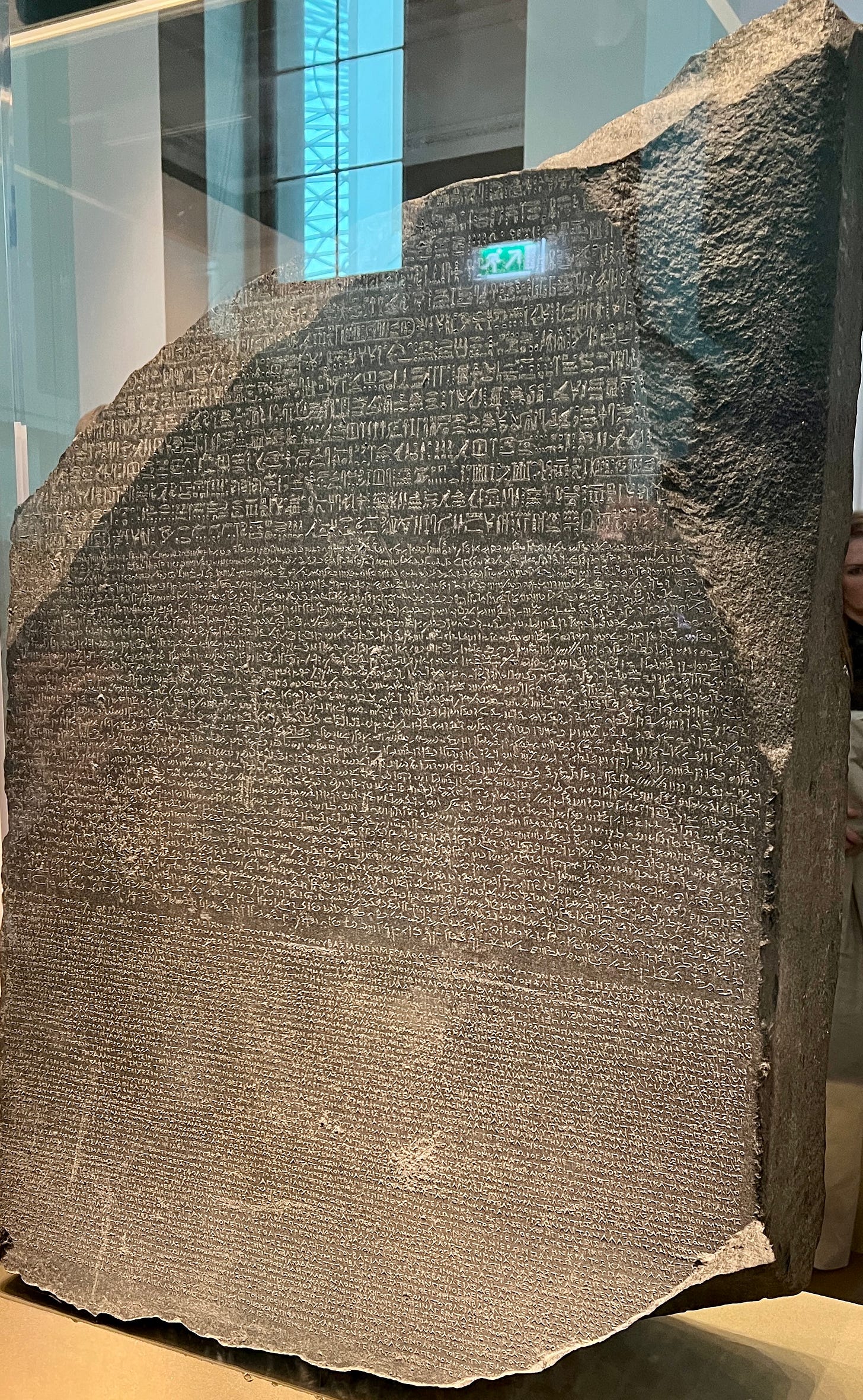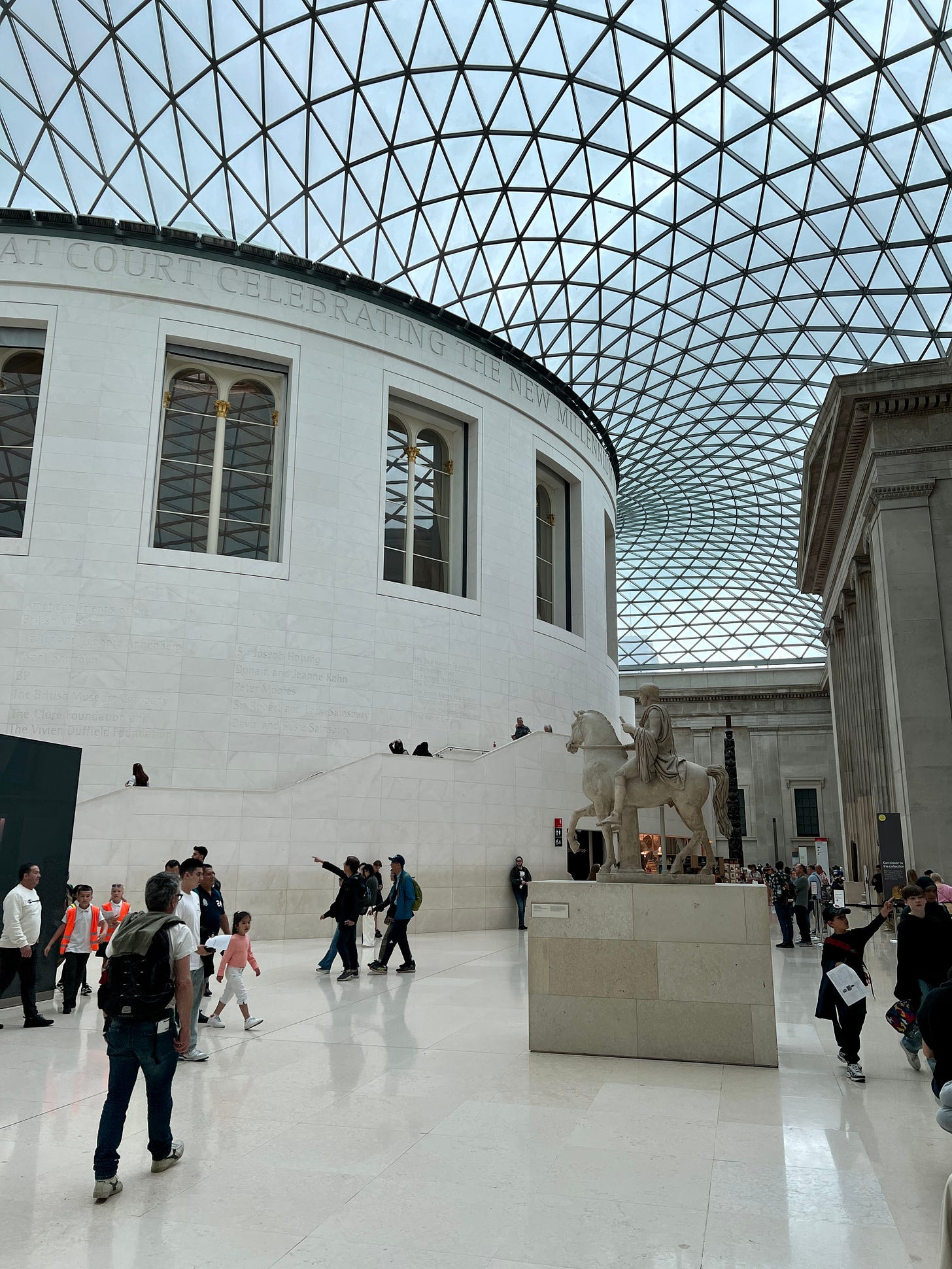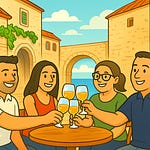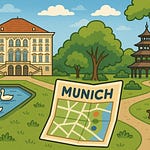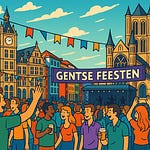Both: Hey everyone!
Jen: It's Jen and Greg with an update on our travels.
Greg: This time we're going to talk about historical places around England that we visited while we were there.
Jen: Yeah, we went to Stonehenge, Bath and the British Museum.
Greg: Yeah, so…we'll begin with Stonehenge. For those who maybe aren't aware, Stonehenge was built around 2500 BC. And we also know from excavating the site — I say “we” like I was a part of it…
Jen: Yeah. (laughs)
Greg: We were told it was built in alignment with the solstices and acted kind of like a calendar so that they would know when it was going to be cold season or when things were going to warm up. Planting season could be timed. Harvest season could be timed. Things like that.
Jen: So some of these stones weigh up to 25 tons and even the smaller ones are up to six tons. And they say that they were all brought in from over 150 miles away.
Greg: Yeah, it's actually a really interesting piece of the engineering that went behind Stonehenge for people who lived like almost 5,000 years ago. I thought it was really, really cool. And I kind of had a lot of awe when we were there at the history of it, the engineering. But I was also disappointed because of how many people were just kind of, like, trying to build up social media clout.
Jen: Yeah, there were several spots that they had around the stones that were giving you clues on how to take the pictures you've probably seen on your Instagram feed of people trying to prop it up or maybe hold it in their hands to where it was really tiny. And the lines for those areas were very long for people to wait to take pictures. So luckily, we went around to the other side and were able to take some pretty good shots with hardly anybody in them.
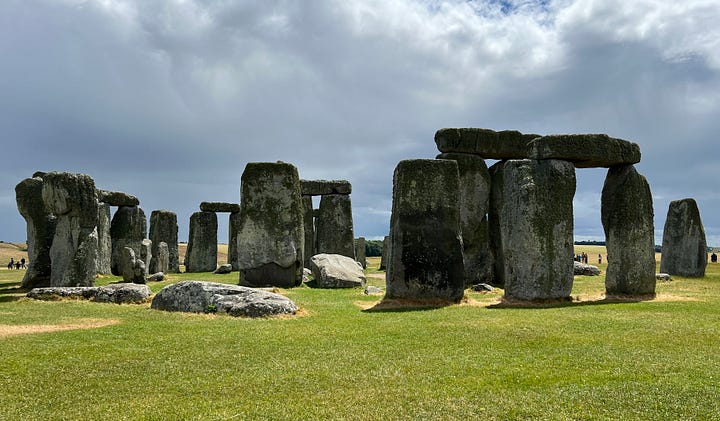
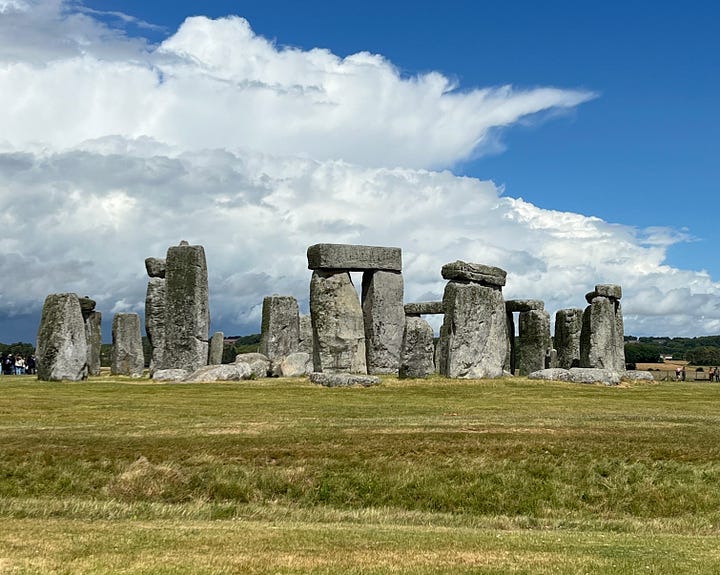
One of the other cool things that's at Stonehenge, too, is an area up near the visitor center that they've done a lot of replicas of the houses that people lived in, the tools they used, and the workshops they used. And what you learn there is that people were really tiny!
Greg: Yes! Some of those doorways you could not walk through without ducking if you were over five feet tall.
Jen: They are small but they are mighty!
Greg: One thing that I know people complain about a lot online that I've read is the road noise because there's a highway very close by. But really, you kind of have to be looking for it. Because we were paying attention to Stonehenge, to the visitor center exhibits and the replica huts. We didn't notice the traffic noise and unless you turn around and look for the highway, it's not really something you see a lot of.
Jen: There were several times where I forgot we were even that close to the road. It did really feel like you were out in the countryside. I would definitely say you should add this to your list if you're in the United Kingdom. It's fun.
Greg: Yeah, I agree.
The second historical site that we visited was a small town called Bath, which was first settled by the Romans about 2,000 years ago when they controlled a big chunk of the British Isles.
Jen: Rome controlled a big chunk of a lot of Europe is what we learned.
Greg: Yes.
Jen: Um, but they chose this specific place because it's located over a naturally occurring hot springs.
Greg: Yeah, and what Romans called baths, we today would say is more like a spa and gym. There was an outdoor pool, but there was also an indoor pool that was heated with a sauna. Right? And the way they did that is a raised floor that had furnaces on either end that pushed a lot of really hot air underneath. So it was really neat. Again, engineering from people thousands of years ago that I was impressed.
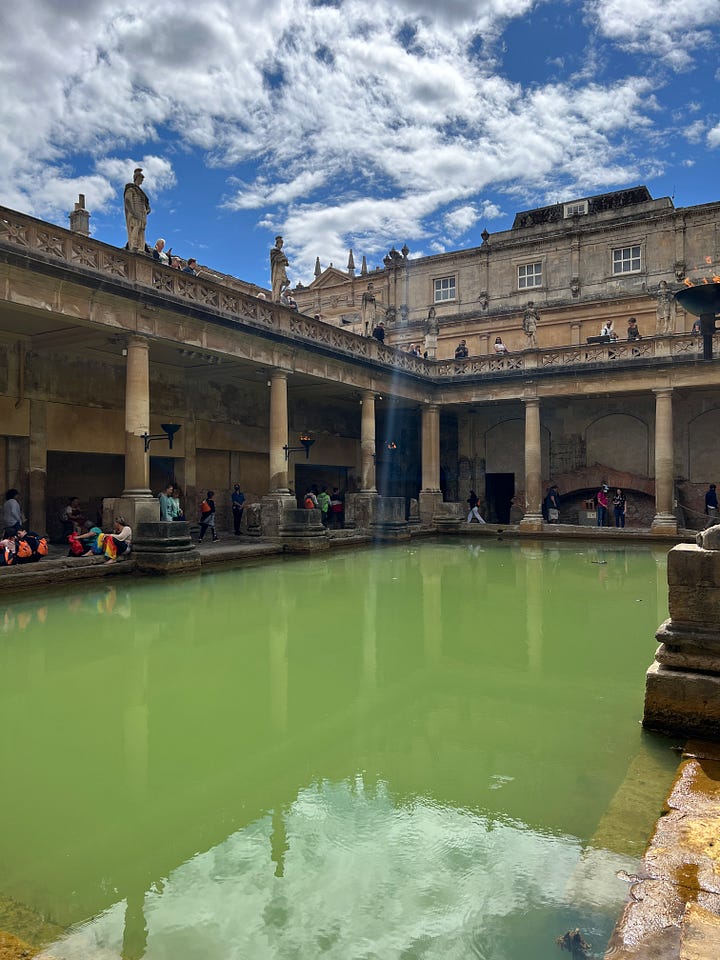
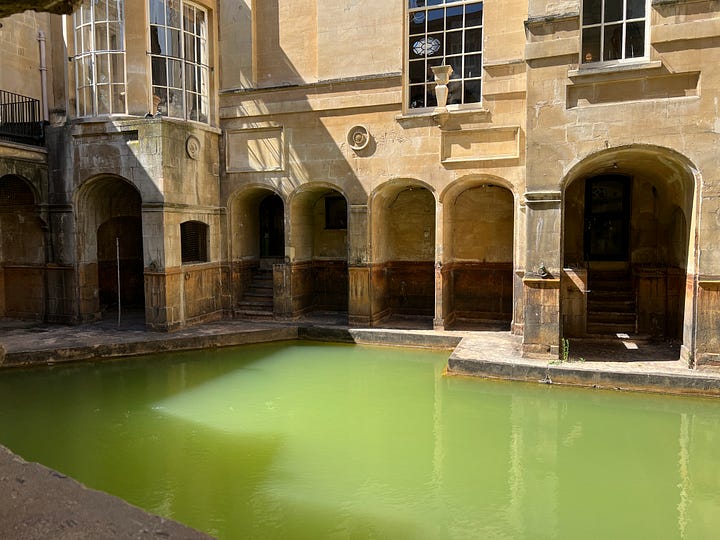
Jen: It was really cool to be able to walk in the footsteps of people from nearly 2,000 years ago and kind of be in the same spaces that they were in. One of the cool things that this place had done was put projections of different scenes on the walls of maybe exercises and games that they played during the time in the gym.
Another thing that they did was they have a little section of the building where you can actually taste the water from the springs. They have a little fountain set up and you can get a little sample cup. So we tasted it.
It wasn't good at all, honestly. It's supposed to have healing properties, but I don't really know how people could drink that over and over again and still be happy with themselves.
Greg: Yeah, it was kind of like a sulfurous taste, right?
Jen: Yeah, it smelled that way too.
Greg: Yeah.
Ah, besides the Roman baths, the town of Bath has another thing that draws people, which is the architecture is iconic Georgian architecture.
Jen: So this Georgian style, if you're not familiar, is named after the four King Georges that ruled England during the time from 1714 to 1830.
Greg: Yeah, it was very charming, I think, overall. You know, they have all the big chimneys stacked one after another.
Jen: Yeah, it reminded me a lot of the scene in Mary Poppins where the chimney sweeps are on top of the roof doing their little dance.
One of the other things - I just remembered - uh, was, because I like to read so much, I found this super interesting, uh, that Jane Austen spent a lot of her time there. If you don't know who Jane Austen is, she wrote Pride and Prejudice and Sense and Sensibility.
And Mary Shelley spent about a year of her life there. She actually wound up writing a good part of Frankenstein there after reading an article where it described electricity and that they thought it might be possible for it to bring inanimate people back to life.
Greg: So that's Bath, which I would say we both enjoyed.
Jen: Yeah.
Greg: The last piece we will discuss is the British Museum. But before we talk about the British Museum itself, we have to tell a story about how we got to the British Museum.
Jen: (laughs) Yeah.
So Russell Square in the London Underground is one of the deeper stations that are built further down under ground. So what that means is you have to go a further distance to get up to street level. You have to take one of two elevators. And as you can imagine, with a busy Underground station, these elevators fill up pretty quickly. Greg seemed to be the only one that was concerned about the maximum capacity of these things so Greg looked at me and said, “This is not happening.” Because, I mean really, people would push on and then more people would push behind. It was not going to be a pleasant or a safe experience.
So we decided to wait on the second one to come. Unfortunately during that time another train arrived in the station so that means more people are going to get in line. Yet another elevator car gets full to capacity. And we just looked at each other and said, “We're going to take those stairs.”
Now, we had heard a couple minutes before an older gentleman say, “You know, those are 176 stairs.” And it's like the second most stairs of any of the Underground stations. But we didn't let that stop us. So we decided to take those 176 steps up to the street level.
And after a little bit, we heard some people coming up from behind us. It was a dad and his son, looked like he was about seven years old. They were moving a lot faster than we were because we honestly had to take a couple breaks because 176 stairs is a lot of stairs to climb.
Greg: Yeah, it is.
Jen: (laughs)
So they were coming up behind us. And as they got closer, an announcement came over the loudspeaker that says, “The stairs are only for emergencies. Please take the elevators.”
So I look at Greg, like, what do you want to do? And the son looks at the dad and the dad looks at Greg, like, what are y'all going to do? And so we all kind of stood there for a second. And then Greg mentioned, “Well, we're probably over halfway there. Let's just go.”
So then that kind of was the dad's like, “Ok, we can all break the rules together!” And we went up the stairs. (laughs)
We hear in a little bit this kid go, WOOHOO! And we knew we were getting close. And there was the light at the end of the tunnel, the street…finally!
Greg: Yeah. So at the top of the steps, we just had to go through the turnstiles. We were out on the street thinking we're here one block from the British Museum. However, that was incorrect. We were one block from the back corner of the British Museum. The entrance was all the way on the other side. And the museum itself is like three blocks in size. It's massive.
So we had to walk - I think was the equivalent of about three or four blocks one way - then another couple of blocks after turning to get to the entrance. And then we weren't done walking because the entrance is just where the line goes through the gate. The line went another block or two past. (laughs)
Jen: (laughs)
So after going up 176 steps, walking seven or eight blocks was killing me!
Jen: The reason the line was so long is most of the museums in London are free, but you still have to reserve your time slot.
Greg: Then you have to go through, which is a lot of standing and walking, after we did the walk to the museum, after we walked up 176 steps. I was really concerned because the museum is not small, and I wanted to see as much as we could.
Jen: Yeah.
Greg: Once you get inside, it really is great. That's why...
Jen: The Great British Museum. (laughs)
Greg: It is. So as an example, right up front, there's this room that's a library that was used by famous people over the time for doing research.
Jen: Mm-hmm.
Greg: There's also all the different exhibits, multiple stories. There's an Easter Island statue. Very cool. There were African costumes that were very reminiscent to us of, like, Mardi Gras costumes that we saw growing up. There's an entire tomb they took from Western Turkey. It's the tomb from Halicarnassas, which they rebuilt in the museum. And it was all just terrific pieces of history and art. There's also Parthenon statues and reliefs. So…very, very cool.
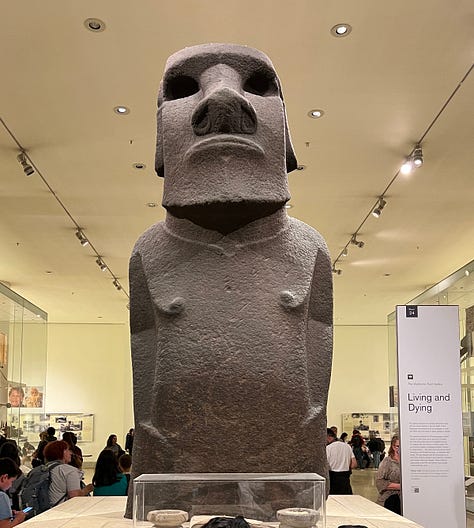
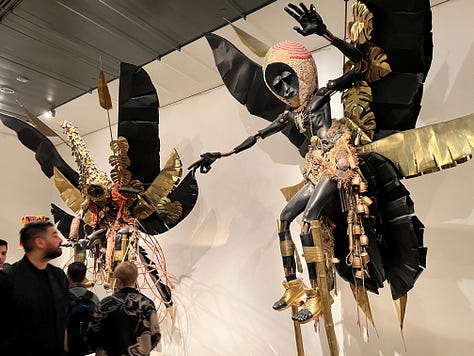
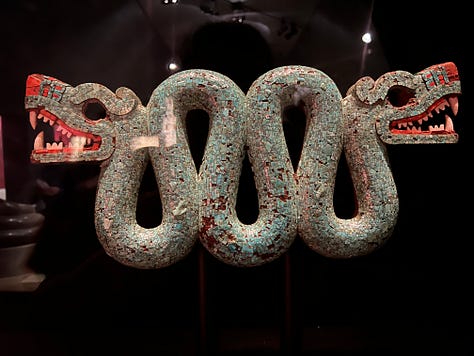
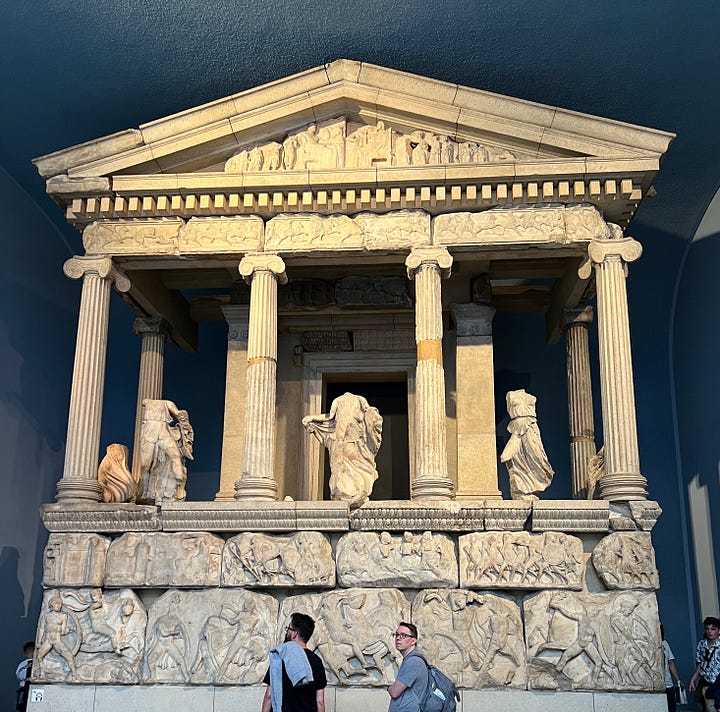
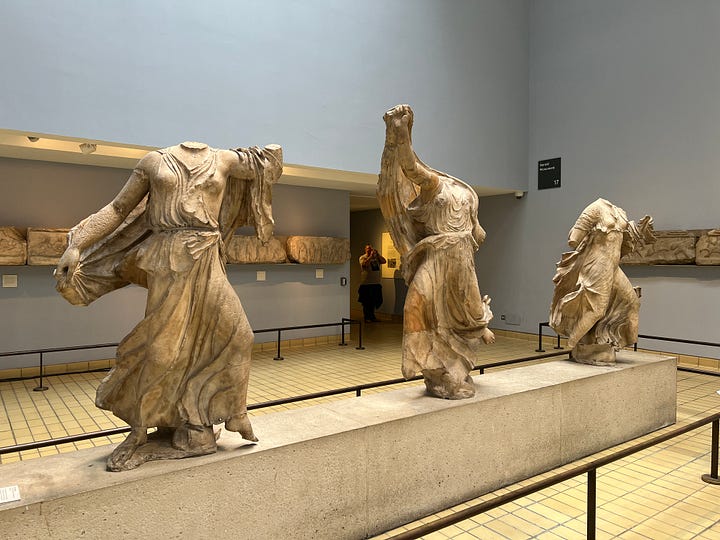
Jen: Right. And there's actually some debate about those statues and reliefs and the rightful ownership of some of the artifacts in the museum itself.
Greg: Yeah, definitely. But I appreciated that they were there so that we could see them.
Jen: And one of the things that is under that debate was probably one of the most impressive things to us to be able to see was the Rosetta Stone.
Greg: And why is the Rosetta Stone so impressive?
Jen: Oh, man…
So the Rosetta Stone is actually kind of a key for us to be able to understand ancient Egyptian hieroglyphics.
Greg: And I was very excited to see it, but it was not what I expected. It was chaotic. There…there was no order.
Jen: So we expected this to be a little more organized than it was. Maybe a special room reserved just for it. Kind of more of like the Mona Lisa, even though there are other things in that room as well. But really, it was in the middle of this long room, just in a glass case, amongst other statues of, like, Ramses and different things.
And it was surrounded by people. So it was really hard to get to, but we finally managed to get up there to the front to be able to see it and get close. And people were swarmed around us. Greg leans over to get a closer look at it. And about a dozen arms fill up the space to start taking up pictures.
Greg: Yeah, I kind of got stuck. The Rosetta Stone is not really like raised up to where it's kind of eye level. It's a couple of feet big, but it's sitting on a base on the floor. So if you really want to get a look at the whole thing at a certain point, you do lean over, that's what I did. And I didn't really have the ability to just stand back up. So I had to slowly kind of begin raising myself. And people reluctantly —
Jen: Yeah.
Greg: — moved their arms and their phones.
But as I was standing up getting my last look of the Stone, some guy - I think he was probably in his 20s - he put his arm over my shoulder while I'm standing up and put his phone literally in front of my face to take a picture of the Stone.
Jen: (laughs)
Greg: And I just turned and looked at Jennifer and was, like, “I'm done. Let's go.”
Jen: Yeah. So we backed our way out of that slowly and moved on. But it was a really cool thing to be able to see.
Greg: Yeah. Everything there is really cool to see.
Jen: I think my favorite part was probably the design of the museum itself. Like you walk in and it's just this enormous atrium with so much natural light. And just the design of it impressed me a lot.
Greg: I think it's actually known for being a very well-designed museum.
So for the most part, that was our historical side of visiting England in and around London. The next update is going to be more about experiences and interactive things.
Jen: Yeah, we went to the Harry Potter Studios, which is a little bit outside of London, but also where they filmed the movie or the movies. And also most recently, if you're a fan of the Food Network, they filmed the Harry Potter Baking Championship there as well.
We also did a tea at the Ampersand. It was a science theme, so that had some neat little elements. And we got dinner with Paul and Sharon, a friend of Greg's mom and his wife.
Greg: Yeah, mom got to know them through her job with insurance, that's what Paul does back in the UK. And it was really great to get dinner with them.
Jen: Yeah, it was fun!
Greg: So thanks for checking in!
Jen: And we'll see you at the next stop!




